目录
match
匹配字符串
单字符匹配
. 匹配任意一个字符
\d 匹配数字
\D 匹配非数字
\s 匹配特殊字符,如空白,空格,tab等
\S 匹配非空白
\w 匹配单词、字符,如大小写字母,数字,_ 下划线
\W 匹配非单词字符
[ ] 匹配[ ]中列举的字符
表示数量
* 出现0次或无数次
+ 至少出现一次
? 1次或则0次
{m}指定出现m次
{m,} 至少出现m次
{m,n} 指定从m-n次的范围
匹配边界
$ 匹配结尾字符
^ 匹配开头字符
\b 匹配一个单词的边界
\B 匹配非单词边界
匹配分组
| 匹配左右任意一个表达式
(ab) 将括号中字符作为一个分组
search
findall
re.s
sub
split
贪婪与非贪婪
案例
匹配手机号
提取网页源码中所有的文字
提取图片地址
从字符串中提取指定范围内的字符串
案例1
案例2
案例3 匹配ip地址
正则表达式是对字符串提取的一套规则,我们把这个规则用正则里面的特定语法表达出来,去匹配满足这个规则的字符串。正则表达式具有通用型,不仅python里面可以用,其他的语言也一样适用。
python中re模块提供了正则表达式的功能,常用的有四个方法(match、search、findall)都可以用于匹配字符串
match
匹配字符串
re.match()必须从字符串开头匹配!match方法尝试从字符串的起始位置匹配一个模式,如果不是起始位置匹配成功的话,match()就返回none。主要参数如下:
re.match(pattern, string)
# pattern 匹配的正则表达式
# string 要匹配的字符串例子
import re
a = re.match('test','testasdtest')
print(a) #返回一个匹配对象
print(a.group()) #返回test,获取不到则报错
print(a.span()) #返回匹配结果的位置,左闭右开区间
print(re.match('test','atestasdtest')) #返回None
从例子中我们可以看出,re.match()方法返回一个匹配的对象,而不是匹配的内容。如果需要返回内容则需要调用group()。通过调用span()可以获得匹配结果的位置。而如果从起始位置开始没有匹配成功,即便其他部分包含需要匹配的内容,re.match()也会返回None。
单字符匹配
以下字符,都匹配单个字符数据。且开头(从字符串0位置开始)没匹配到,即使字符串其他部分包含需要匹配的内容,.match也会返回none
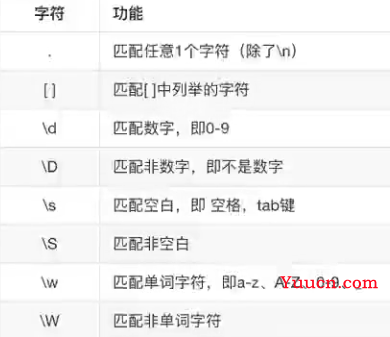
. 匹配任意一个字符
使用几个点号就代表几个字符
import re
a = re.match('..','testasdtest')
print(a.group()) #输出te
b = re.match('ab.','testasdtest')
print(b) #返回none,因为表达式是以固定的ab开头然后跟上通配符. 所以必须要先匹配上ab才会往后进行匹配![]()
\d 匹配数字
一个\d代表一个数字。开头没匹配到,即使字符串其他部分包含需要匹配的内容,.match也会返回none
import re
a = re.match('\d\d','23es12testasdtest')
print(a)
b = re.match('\d\d\d','23es12testasdtest')
print(b) #要求匹配三个数字,匹配不到返回none
c = re.match('\d','es12testasdtest')
print(c) #起始位置没有匹配成功,一样返回none
\D 匹配非数字
开头没匹配到,即使字符串其他部分包含需要匹配的内容,.match也会返回none
import re
a = re.match('\D','23es12testasdtest')
print(a) #开头为数字所以返回none
b = re.match('\D\D','*es12testasdtest')
print(b) #返回*e\s 匹配特殊字符,如空白,空格,tab等
import re
print(re.match('\s',' 23es 12testasdtest')) #匹配空格
print(re.match('\s',' 23es 12testasdtest')) #匹配tab
print(re.match('\s','\r23es 12testasdtest')) #匹配\r换行
print(re.match('\s','23es 12testasdtest')) #返回none
\S 匹配非空白
import re
print(re.match('\S',' 23es 12testasdtest')) #返回none
print(re.match('\S','\r23es 12testasdtest')) #none
print(re.match('\S','23es 12testasdtest')) 
\w 匹配单词、字符,如大小写字母,数字,_ 下划线
import re
print(re.match('\w','23es 12testasdtest')) #返回none
print(re.match('\w\w\w','aA_3es 12testasdtest')) #返回none
print(re.match('\w\w\w','\n12testasdtest')) #返回none

\W 匹配非单词字符
import re
print(re.match('\W','23es 12testasdtest')) #返回none
print(re.match('\W',' 23es 12testasdtest')) #匹配空格![]()
[ ] 匹配[ ]中列举的字符
只允许出现[ ]中列举的字符
import re
print(re.match('12[234]','232s12testasdtest')) #因为开头的12没匹配上,所以直接返回none
print(re.match('12[234]','1232s12testasdtest')) #返回123
[^2345] 不匹配2345中的任意一个
import re
print(re.match('12[^234]','232s12testasdtest')) #因为开头的12没匹配上,所以直接返回none
print(re.match('12[^234]','1232s12testasdtest')) #返回none
print(re.match('12[^234]','1252s12testasdtest')) #返回125[a-z3-5] 匹配a-z或者3-5中的字符
import re
print(re.match('12[1-3a-c]','1232b12testasdtest')) #123
print(re.match('12[1-3a-c]','12b2b12testasdtest')) #12b
print(re.match('12[1-3a-c]','12s2b12testasdtest')) #返回none表示数量
像上面写的那些都是匹配单个字符,如果我们要匹配多个字符的话,只能重复写匹配符。这样显然是不人性化的,所以我们还需要学习表达数量的字符
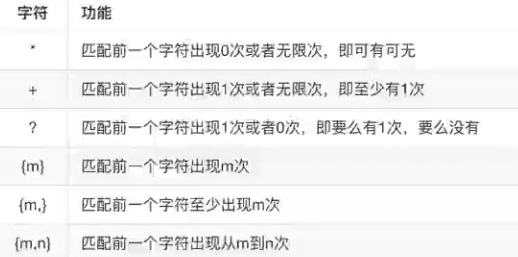
* 出现0次或无数次
import re
a = re.match('..','testasdtest')
print(a.group()) #输出te
a = re.match('.*','testasdtest')
print(a.group()) #全部输出![]()
import re
print(re.match('a*','aatestasdtest')) #匹配跟随在字母a后面的所有a字符
print(re.match('\d*','23aatestasdtest')) #匹配前面为数字的字符
print(re.match('a\d*','ad23aatestasdtest')) #输出a, 因为*也可以代表0次

+ 至少出现一次
import re
print(re.match('a+','aaatestasdtest')) #匹配前面为字母a的字符,且a至少有1一个
print(re.match('a+','atestasdtest')) #a
print(re.match('a+','caaatestasdtest')) #none
? 1次或则0次
import re
print(re.match('a?','abatestasdtest')) #匹配a出现0次或者1次数
print(re.match('a?','batestasdtest')) #输出空,因为a可以为0次
print(re.match('a?','aaatestasdtest')) #a出现0次或者1次,输出1个a
{m}指定出现m次
import re
print(re.match('to{3}','toooooabatestasdtest')) #匹配t以及跟随在后面的三个ooo
print(re.match('to{3}','tooabatestasdtest')) #只有两个0,返回none![]()
{m,} 至少出现m次
import re
print(re.match('to{3,}','toooooabatestasdtest')) #匹配t以及跟随在后面的三个ooo至少出现3次
print(re.match('to{3,}','tooabatestasdtest')) #只有两个0,返回none![]()
{m,n} 指定从m-n次的范围
import re
print(re.match('to{3,4}','toooabatestasdtest')) #刚好有三个ooo,成功匹配
print(re.match('to{3,4}','tooabatestasdtest')) #只有两个o,返回none
print(re.match('to{3,4}','toooooabatestasdtest')) #提取最多四个o
匹配边界
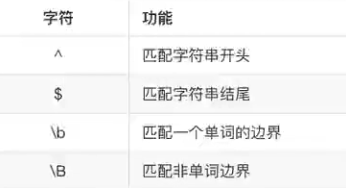
$ 匹配结尾字符
定义整个字符串必须以指定字符串结尾
import re
print(re.match('.*d$','2testaabcd')) #字符串必须以d结尾
print(re.match('.*c','2testaabcd')) #字符串不是以c结尾,返回none![]()
^ 匹配开头字符
定义整个字符串必须以指定字符开头
import re
print(re.match('^2','2stoooabatestas')) #规定必须以2开头,否则none
print(re.match('^2s','2stoooabatestas')) #必须以2s开头\b 匹配一个单词的边界
\b:表示字母数字与非字母数字的边界,非字母数字与字母数字的边界。即下面ve的右边不能有字母和数字
import re
print(re.match(r'.*ve\b','ve.2testaabcd')) #因为在python中\代表转义,所以前面加上r消除转义
print(re.match(r'.*ve\b','ve2testaabcd'))
\B 匹配非单词边界
import re
print(re.match(r'.*ve\B','2testaavebcdve')) #ve的右边需要有字母或者数字
print(re.match(r'.*ve\B','2testaave3bcdve'))![]()
匹配分组
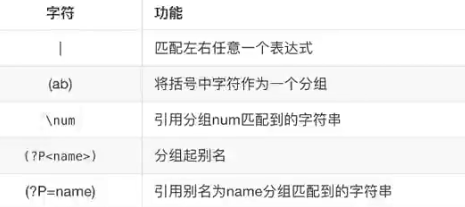
| 匹配左右任意一个表达式
只要|两边任意一个表达式符合要求就行
import re
print(re.match(r'\d[1-9]|\D[a-z]','2233')) #匹配|两边任意一个表达式
print(re.match(r'\d[1-9]|\D[a-z]','as')) ![]()
(ab) 将括号中字符作为一个分组
()中的内容会作为一个元组字符装在元组中
import re
a = re.match(r'<h1>(.*)<h1>','<h1>你好啊<h1>')
print(a.group()) #输出匹配的字符
print(a.groups()) #会将()中的内容会作为一个元组字符装在元组中
print('`````````````')
b = re.match(r'<h1>(.*)(<h1>)','<h1>你好啊<h1>')
print(b.groups()) #有两括号就分为两个元组元素
print(b.group(0)) #group中默认是0
print(b.group(1)) #你好啊
print(b.group(2)) #h1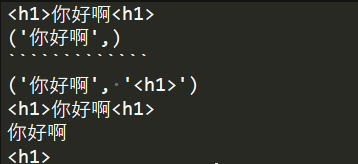
search
和match差不多用法,从字符串中进行搜索
import re
print(re.match(r'\d\d','123test123test'))
print(re.search(r'\d\d','123test123test'))
findall
从字面意思上就可以看到,findall是寻找所有能匹配到的字符,并以列表的方式返回
import re
print(re.search(r'test','123test123test'))
print(re.findall(r'test','123test123test')) #以列表的方式返回
re.s
findall中另外一个属性re.S
在字符串a中,包含换行符\n,在这种情况下
- 如果不使用re.S参数,则只在每一行内进行匹配,如果一行没有,就换下一行重新开始。
- 而使用re.S参数以后,正则表达式会将这个字符串作为一个整体,在整体中进行匹配。
如下要寻找test.*123的数据,因为test和123在不同的行,如果没加re.s的话,他会在每一个进行匹配查找而不是将字符串作为一个整体进行查找
import re
a = """aaatestaa
aaaa123"""
print(re.findall(r'test.*123',a))
print(re.findall(r'test.*123',a,re.S))
sub
查找字符串中所有相匹配的数据进行替换
sub(要替换的数据,替换成什么,要替换的数据所在的数据)
import re
print(re.sub('php','python','php是世界上最好的语言——php'))
#输出 "python是世界上最好的语言——python"
split
对字符串进行分割,并返回一个列表
import re
s = "itcase,java:php-php3;html"
print(re.split(r",",s)) #以,号进行分割
print(re.split(r",|:|-|;",s)) #以,或者:或者-或者;进行分割
print(re.split(r",|:|-|%",s)) #找不到的分隔符就忽略
贪婪与非贪婪
python里的数量词默认是贪婪的,总是尝试尽可能的匹配更多的字符。python中使用?号关闭贪婪模式
如
import re
print(re.match(r"aa\d+","aa2323")) #会尽可能多的去匹配\d
print(re.match(r"aa\d+?","aa2323")) #尽可能少的去匹配\d
import re
s = "this is a number 234-235-22-423"
# 1.贪婪模式
resule = re.match(r"(.+)(\d+-\d+-\d+-\d)",s) #我们本想数字和字母拆解成两个分组
print(resule.groups()) #('this is a number 23', '4-235-22-4')但我们发现输出的结果中23的数字竟然被弄到前面去了
#因为+它会尽可能多的进行匹配,\d,只需要一个4就能满足,所以前面就尽可能多的匹配
# 2.关闭贪婪模式
#在数量词后面加上 ?,进入非贪婪模式,尽可能少的进行匹配
result = re.match(r"(.+?)(\d+-\d+-\d+-\d)",s)
print(result.groups()) #('this is a number ', '234-235-22-4')
案例
匹配手机号
要求,手机号为11位,必须以1开头,且第二个数字为35678其种一个
import re
result = re.match(r'1[35678]\d{9}','13111111111')
print(result.group()) #匹配成功
result = re.match(r'1[35678]\d{9}','12111111111')
print(result) #none,第二位为2
result = re.match(r'1[35678]\d{9}','121111111112')
print(result) #none,有12位
提取网页源码中所有的文字
如下,将其中的所有文字提取出来,去掉标签。思路就是运用sub方法,将标签替换为空
s = """<div>
<p>岗位职责:</p>
<p>完成推荐算法、数据统计、接口、后台等服务器端相关工作</p>
<p><br></p>
<P>必备要求:</p>
<p>良好的自我驱动力和职业素养,工作积极主动、结果导向</p>
<p> <br></p>
<p>技术要求:</p>
<p>1、一年以上 Python开发经验,掌握面向对象分析和设计,了解设计模式</p>
<p>2、掌握HTTP协议,熟悉NVC、MVVM等概念以及相关wEB开发框架</p>
<p>3、掌握关系数据库开发设计,掌握SQL,熟练使用 MySQL/PostgresQL中的一种<br></p>
<p>4、掌握NoSQL、MQ,熟练使用对应技术解决方案</p>
<p>5、熟悉 Javascript/cSS/HTML5,JQuery,React.Vue.js</p>
<p> <br></p>
<p>加分项:</p>
<p>大数据,数理统计,机器学习,sklearn,高性能,大并发。</p>
</div>"""要提取出来最重要的就是关闭贪婪模式,
result = re.sub(r'<.*?>| ','',s) #
print(result)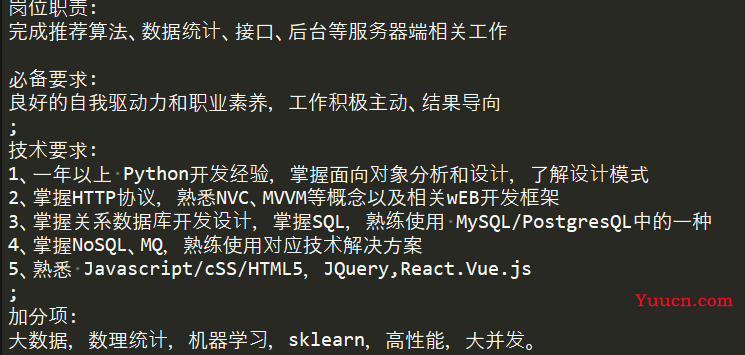
如果关闭贪婪模式,<xx>中的内容会尽可能少的匹配,只要能够满足后面的>就行,然后<>xxx<>中xxx内容也替换掉了
提取图片地址
import re
s = """<img data-original="" src="" width="250" height="375" .jpg>"""
result1 = re.search(r"src=\"https.*.jpg\"",s)
print(result1.group())
result2 = re.search(r"src=\"(https.*.jpg)\"",s) #我只是想将网址提取出来,所以httpxx加括号,这样我就可以把它单独提取出来,src则不会出来
print(result2.groups()[0])
从字符串中提取指定范围内的字符串
案例1
如想从
"
csrftoken=ZjfvZBcDMcVs7kzYqexJqtKiJXIDxcmSnXhGD1ObR2deuHzaU0FuCxSmh10fSmhf; expires=Thu, 29 Jun 2023 07:59:04 GMT; Max-Age=31449600; Path=/; SameSite=Lax
”
里面提取出token值
import re
str = "csrftoken=ZjfvZBcDMcVs7kzYqexJqtKiJXIDxcmSnXhGD1ObR2deuHzaU0FuCxSmh10fSmhf; expires=Thu, 29 Jun 2023 07:59:04 GMT; Max-Age=31449600; Path=/; SameSite=Lax"
a = re.search(r'=(.*?);', str)
print(a.group(1)) #输出匹配的字符
案例2
从响应包里提取关键词所在的行,可以在正则中添加变量
import re
key = "威胁"
a = """
<body data-spm="7663354">
<div data-spm="1998410538">
<div class="header">
<div class="container">
<div class="message">
很抱歉,由于您访问的URL有可能对网站造成安全威胁,您的访问被阻断。
<div>您的请求ID是: <strong>
781bad0a16702307419116917e43b3</strong></div>
</div>
</div>
</div>
"""
res = re.search(r'<.*>(.*?%s.*?)<.*?>'%(key),a,re.S)
print(res.group(1).replace("\n","").replace(" ",""))
案例3 匹配ip地址
简单的匹配一下ip地址
import re
str = "http://10.1.1.1/index.html"
try:
s = re.search("\d*?\.\d*?\.\d*?\.\d*",str)
print(s.group())
except:
print("未能匹配出ip地址")